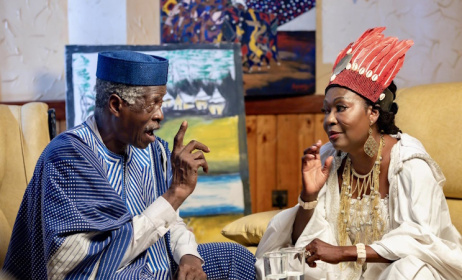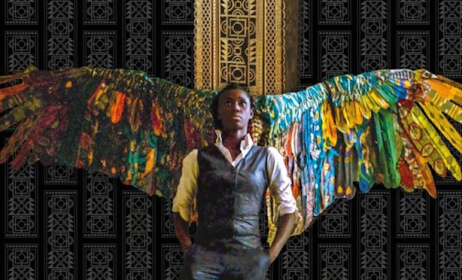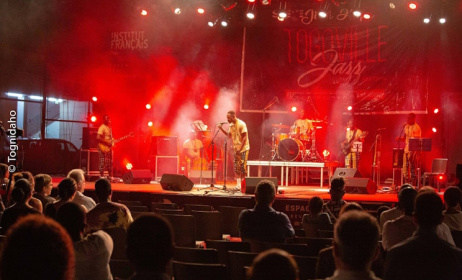Beninese women in music
By Djamile Mama Gao
Music, like other creative sectors in Benin, is filled with talented people, but unfortunately it is also full of insidious mechanisms of exclusion towards some. Women have long been marginalised. However, the evolution of certain cultural practices has helped women feel more confident and bold, allowing them to follow their dreams. Thus, they are able to transgress societal norms and flourish in a sector that is largely dominated by men.
 Angelique Kidjo.
Angelique Kidjo.
The pioneers
Women have always been an important part in the history of Beninese music, which goes back to the days of the oral tradition. Indeed, female griots have always been present among the country’s different ethnic groups. These women were either praise singers, mourners, storytellers, singers or players of traditional instruments during the time of castanets, gongs and artisanal flutes. During the oral age, griots were considered to be the guardians of the social values and traditions of communities. One such traditional musician is Gnon Yerekou of Tchaourou.
However, it was not until about the 1960s that women emerged in the modern music industry. This wasn’t an easy process: female musicians were facing sexism, demeaning criticism and intimidation. Despite such pressures, music pioneer Edia Sophie managed to become the first woman to play a central role in a big orchestra – the Renova Band.
The ‘awakening’ of women in the music industry took place almost simultaneously around the country at the beginning of the independence era (1960) when about 80 female singers began to emerge on the local music scene. What could often be heard through their voices was anguish for the post-colonial era and common aspirations of peace. Vivi l'Internationale was one of the most prominent voices during Benin’s revolutionary period and was active in social and political activism.
Kiri Kanta is another prominent singer, who emerged in the northern region of the country in 1978. Her vocal timbre and Sahelian accent allowed her to employ her style in orchestras where she sang lead vocals, in particular the orchestra of Parakou textile group Ibetex of Sagbohan Danialou and Stan Tohon. She has launched three albums during her career: Ignin Mindassan (1991), Contrat abeni (Germany, 1993) and Simbori (2000). She was raised to the rank of Chevalier dans l’Ordre du Mérite (Chevalier/Knight in the Order of Merit) in 1995.
Angelique Kidjo
Angélique Kidjo took her first steps in the music scene at the age of six. She learnt the basics of the craft from her mother and brothers. Her wide vocal range mixes soul, R&B, jazz, funk and African music. She first gained fame in the sub-region and later internationally in countries such as France and the US, among others. Alongside her bassist husband Jean Hebraïl, she has been the most successful Beninese artists since the 1990s. Kidjo has released 14 albums since and is famous around the world for her charismatic stage presence and volcanic temperament that never fails to wow audiences.
Other famous female voices in Benin today include Rek Souza, whose style is the synthesis of Western pop and two traditional rhythms: the agbadjahungbo, the Hausa version of the Fon rhythm aogbahoun, and the alizonhoun, the Hausa marching sound that is used during certain religious ceremonies. Assy Kiwah is another female musician who is known for her hit ‘Hwetanou’(2000) which unveils a Beninese reality delicately comprising the Fongbe, Yoruba and Dendi languages as well as its people and their talents.
The new generation
The total presence of women across most music-related professions in Benin could be close to 30%, with a highly variable distribution according to the positions they take up. For example, women are almost non-existent in managerial positions, with only about 5% representation. However, they represent almost 60% of backing vocalists, whether in studio or at concerts. This is probably why there is a much larger proportion of women vocalists and dancers than instrumentalists.
There is an all-female orchestra in the city of Parakou and of course there are many female musicians everywhere else in the country. But there is almost no professional women who make a living solely from music. This information, however, is supported only by observations and testimonies and not by statistics, which still remain rare in the sector.
In any case, Beninese women in music could be split into five main branches: traditional, religious, world, pop and urban music.
Traditional music is dominated by Norbèka, Trio Tériba, Sena Noble (Eloïse Degui), Sèdami (Valérie Azondékon) and Princess Esther Tissoh.
‘Tradi-modern’ music is one of Benin's most popular musical genres, because artists find it to be an appropriate balance between socio-cultural and geographic anchoring, the transmission of identity and the recreation of a new idiom that still relates to the present times. Female artists in the tradi-modern scene include Nono Miwa, Blandine N'tcha, Lisa Sala, Yolande Koupey, Stard Love, Marie Sinoubey, Ria Kante, Princess Stella, Mariam Kankarou, Fanny Sènan, Akodjènou Noëllie, Marlene Zinsou, Zérina Adjéoda, Princess Sika, Sena Joy, Justine Singbo, Tata Grace, Princess Amaya, Edwige Hessou and Ba Flora.
World music, a mix of music from Benin and beyond, is generally perceived as a refined genre for beginners. This seem to be a justification as to why world music artists enjoy more visibility outside the country than at home. This is true for artists such as Pépé Oléka, Koudy Fagbèmi, Nila Djogbe, Madou, Falyssath, Kiinzah, Ramou, Fafa Ruffino, Zeynab Habib, Ifè, Faty Kouchekeho and Sessimè.
Popular music in Benin can be defined by the fact that it brings together artists whose music meets a festive and/or dance vocation. Although it often talks about various personal and societal issues, popular music in Benin music is largely commercial and therefore more profitable, and intended for a wider audience. Stylistically it borrows from genres such as the noudjihou and gogohoun. Apart from local sounds, it also borrows the music of Ivory Coast, Congo and others. Artists in Beninese popular music include Okine, Ella Martins, Chokki, Miss Espoir, Oluwa Kêmy, Dossi, Pélagie la vibreuse, La Go H-Ley, Lady G (Lydie Glèlè), Oket Baya, Princesse Charm, Nelly, Linda Dossou, As de Pik, Giselle H, Valerie Mignon, Line Star, Lyss Mouss, Méola, Castella Ayilo and Emmanuelle de Souza.
Religious music in Benin is above all dominated by the gospel genre. Anna Teko is one of the biggest name in gospel music. Her music peers are Dona Chanvoedou, Sandra Heriti, Joyce Mambo and more recently Will Honor.
Urban music is dominated by rap, R&B, reggae and slam. Such artists include Naria, Mady, Eïssy, Sèdodé, Caress, Harmonie ByllCatarya, Beezy Baby, Kouadja, and Sadky.
Conclusion
Despite the difficulties linked to the precariousness of the music industry in Benin, women fight hard to exist and to impose themselves on the music scene. However, their weakness in this environment is either due to lack of training or lack of a skilled team to support them. The lack of a proper communication and marketing strategy to promote their work is also part of the problem.
Apart from a very few artists who pursue their musical career on a full-time basis, female musicians in Benin can be defined as amateurs. This is because they have to be involved in other professions that are more profitable than music. It is therefore possible that economic reforms in the sector could make the careers of female musicians in Benin more sustainable.


























Commentaires
s'identifier or register to post comments